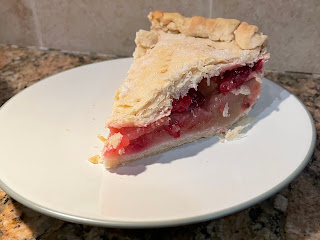For us, Mardi Gras season means an opportunity to enjoy some good New Orleans-style food. With this year's Super Bowl also being in New Orleans, we took advantage of the opportunity to "practice" a new recipe in advance of Mardi Gras - the muffuletta.
The muffuletta doesn't have the same Creole or Cajun origins as other typical New Orleans cuisine. At the same time, it does represent the contributions of individuals from multiple nationalities. The muffuletta is believed to have originated at Central Grocery in New Orleans - the creation of an immigrant from Sicily. The muffuletta features a muffuletta loaf - think very oversized burger bun, olive salad, deli meats and provolone and/or Swiss cheese.
Just what is olive salad? It's actually a rather tasty mixture of chopped olives, cauliflower, carrots, onions, herbs, vinegar, and oil. You can also think of it as chopped up giardiniera (pickled carrots, cauliflower, celery, and onion) with chopped olives, herbs, and a little oil stirred in. We opted to order a 2-pack from Central Grocery - one for the Super Bowl and one for Mardi Gras.
With that, let's get to making the muffuletta loaf - think of it as something like a 12 to 14-inch hamburger bun. It's basically a typical bread recipe with some specifications for how you shape and bake it.
Here are the ingredients for the loaf:
- 1 cup warm water - about 105-110 degrees Fahrenheit
- 1 tablespoon sugar
- 2 teaspoons yeast (if you buy it in packets, just use a whole packet)
- 3 cups bread flour (you can use all-purpose if that's what you have, too)
- 1.5 teaspoons salt
- 2 tablespoons vegetable shortening
- 1 egg, beaten
- 2 tablespoons sesame seeds
1.Combine the water, sugar, and yeast and allow to sit for 5-10 minutes until the yeast starts to bloom.
2. Combine the flour and salt. Then mix in the shortening until blended in.
3. Add in the yeast mixture and mix for about 5 or 6 minutes until a smooth dough forms.
4. Place the dough in a well-oiled bowl. Cover and let rise until doubled in bulk, about one hour.
5. Punch the dough down, shape into about a 10 to 12-inch disc. Place on a lined baking sheet. (We like using our silicone sheet liners.) Here's what it will look like. We let the disc rise for about another 15 minutes or so, too.
6. Brush the top of the dough with the beaten egg and sprinkle the sesame seeds over the top.
7. Preheat the oven to 450 degrees Fahrenheit. Fill a pan with water (we use a glass pie pan) and place on the bottom rack of the oven
8. Bake for 5 minutes, then carefully remove the dish with water.
9. Reduce the temperature to 375 degrees Fahrenheit and bake for another 25 minutes or so. The top should be golden brown and sound hollow when it is tapped. It will look something like this.
10. Allow the loaf to cool and then slice it in half horizontally. Now it's time to assemble!
Assembling the Muffaletta
- One 16-ounce jar of Central Grocery olive salad - feel free to create your own if you wish
- A nice selection of deli meats: mortadella, salami, capicola, soppressata, ham (go to a nice deli and get the good stuff!)
- Cheese: we used provolone. You can also use Swiss
1. Spread the marinade from the olive salad over each half of the muffuletta loaf. You do want it to soak into the bread nicely. Feel free to supplement with a little vinaigrette or Italian salad dressing if needed.
2. Spread about half of the olive salad on the bottom half of the loaf.
3. Layer up with meat and cheese as desired.
4. Spread the remaining olive salad on top.
5. Place the upper half of the loaf on top and there you go!
6. Cut the muffuletta into wedges and enjoy! We served ours up with some smoked sausage Creole. We even decided to do things up fancy with the nice china.
7. Wrap any remaining muffuletta wedges up in plastic wrap and refrigerate. You then have ready to go sandwiches that are even better the next day. Muffulettas can be served warm or cold. We like warming them up for about 30 seconds in the microwave.
8. Don't forget the King Cake!



























